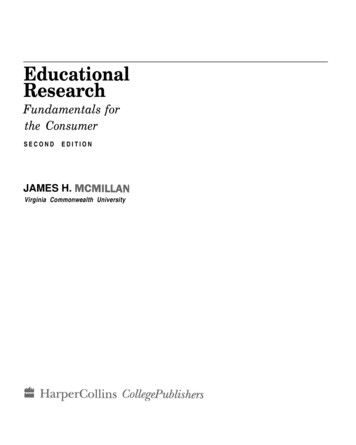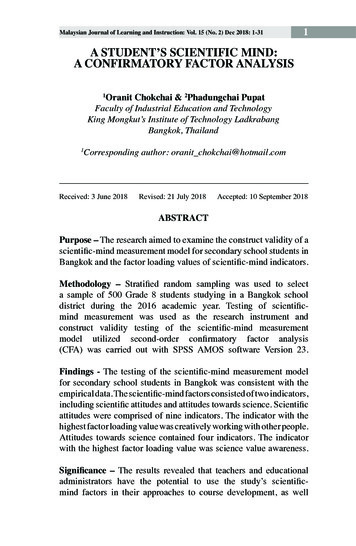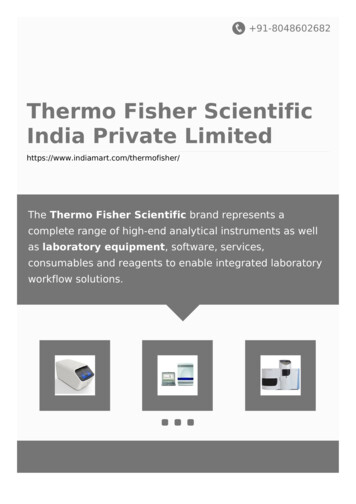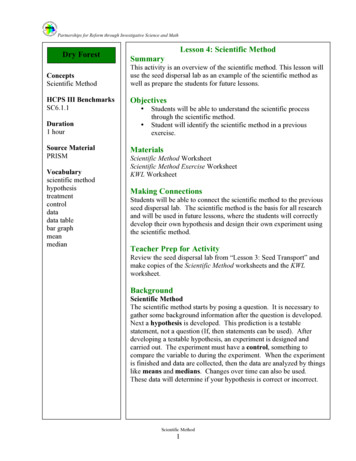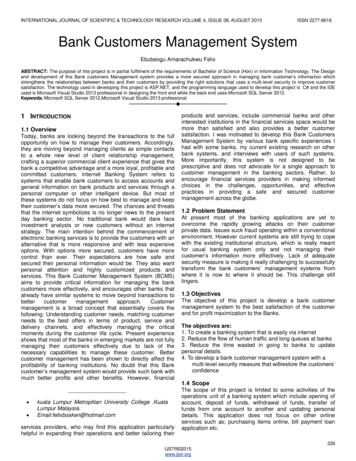
Transcription
INTERNATIONAL JOURNAL OF SCIENTIFIC & TECHNOLOGY RESEARCH VOLUME 4, ISSUE 08, AUGUST 2015ISSN 2277-8616Bank Customers Management SystemEbubeogu Amarachukwu FelixABSTRACT: The purpose of this project is in partial fulfilment of the requirements of Bachelor of Science (Hon) in Information Technology. The Designand development of this Bank customers Management system provides a more secured approach in managing bank customer’s information whichstrengthens the relationships between banks and their customers by providing the right solutions that uses a multi-level security to improve customersatisfaction. The technology used in developing this project is ASP.NET, and the programming language used to develop this project is C# and the IDEused is Microsoft Visual Studio 2013 professional in designing the front end while the back end uses Microsoft SQL Server 2012.Keywords: Microsoft SQL Server 2012,Microsoft Visual Studio 2013 professional—————————— ——————————1 INTRODUCTION1.1 OverviewToday, banks are looking beyond the transactions to the fullopportunity on how to manage their customers. Accordingly,they are moving beyond managing clients as simple contactsto a whole new level of client relationship management,crafting a superior commercial client experience that gives thebank a competitive advantage and a more loyal, profitable andcommitted customers. Internet Banking System refers tosystems that enable bank customers to access accounts andgeneral information on bank products and services through apersonal computer or other intelligent device. But most ofthese systems do not focus on how best to manage and keeptheir customer’s data more secured. The chances and threatsthat the internet symbolizes is no longer news to the presentday banking sector. No traditional bank would dare faceinvestment analysts or new customers without an internetstrategy. The main intention behind the commencement ofelectronic banking services is to provide the customers with analternative that is more responsive and with less expensiveoptions. With options more secured, customers have morecontrol than ever. Their expectations are how safe andsecured their personal information would be. They also wantpersonal attention and highly customized products andservices. This Bank Customer Management System (BCMS)aims to provide critical information for managing the bankcustomers more effectively, and encourages other banks thatalready have similar systems to move beyond transactions ent is a broad concept that essentially covers thefollowing: Understanding customer needs, matching customerneeds to the best offers in terms of product, service anddelivery channels, and effectively managing the criticalmoments during the customer life cycle. Present experienceshows that most of the banks in emerging markets are not fullymanaging their customers effectively due to lack of thenecessary capabilities to manage these customer. Bettercustomer management has been shown to directly affect theprofitability of banking institutions. No doubt that this Bankcustomer’s management system would provide such bank withmuch better profits and other benefits. However, financial kuala Lumpur Metroplitan University College .KualaLumpur Malaysia.Email:felixbosken@hotmail.comservices providers, who may find this application particularlyhelpful in expanding their operations and better tailoring theirproducts and services, include commercial banks and otherinterested institutions in the financial services space would bemore than satisfied and also provides a better customersatisfaction. I was motivated to develop this Bank CustomersManagement System by various bank specific experiences Ihad with some banks, my current existing research on otherbank systems, and interviews with users of such systems.More importantly, this system is not designed to beprescriptive and does not advocate for a single approach tocustomer management in the banking sectors. Rather, toencourage financial services providers in making informedchoices in the challenges, opportunities, and effectivepractices in providing a safe and secured customermanagement across the globe.1.2 Problem StatementAt present most of the banking applications are yet toovercome the rapidly growing attacks on their customerprivate data. Issues suck fraud operating within a conventionalenvironment. However current systems are still trying to copewith the existing institutional structure, which is really meantfor usual banking system only and not managing theircustomer’s information more effectively. Lack of adequatesecurity measure is making it really challenging to successfullytransform the bank customers’ management systems fromwhere it is now to where it should be. This challenge stilllingers.1.3 ObjectivesThe objective of this project is develop a bank customermanagement system to the best satisfaction of the customerand for profit maximization to the Banks.The objectives are:1. To create a banking system that is easily via internet2. Reduce the flow of human traffic and long queues at banks3. Reduce the time wasted in going to banks to updatepersonal details.4. To develop a bank customer management system with amulti-level security measure that willrestore the customers’confidence1.4 ScopeThe scope of this project is limited to some activities of theoperations unit of a banking system which include opening ofaccount, deposit of funds, withdrawal of funds, transfer offunds from one account to another and updating personaldetails. This application does not focus on other onlineservices such as; purchasing items online, bill payment loanapplication etc.326IJSTR 2015www.ijstr.org
INTERNATIONAL JOURNAL OF SCIENTIFIC & TECHNOLOGY RESEARCH VOLUME 4, ISSUE 08, AUGUST 20151.5 Justification of the ProjectOn a successful completion and implementation of this project,users/customers will be rest assured that no amount of onlinethreat from hacker and other attackers can penetrate theiraccount even when their password is compromised.This application uses a multi-level security measure to ensurethat customers’ personal details and account information aresafe.1.6 Organization of the Report Chapter 1 covers the overview, problem statement,objective, scope, Justification of the project, and theorganization of the report as stated (1.6 above). Chapter 2 deals with the literature review or systemreview which is based on the existing systems withcomparison and the summary of those systems. In chapter 3 is about the methodology, review themethodologies of system development, choose themethodology or framework, the system requirementanalysis which is comprises the hardwarerequirement and software requirement in which thissystem will be developed. Chapter 4 provides the system analysis, results andthe discussions. The functional and non-functionalrequirement; the system architecture which is usecase diagram, activity diagram, data flow or sequencediagram, entity relationship diagram and unit testing. Chapter 5 will be conclusion; which includes theconcluding remarks, contribution, limitation of thesystem, suggestion of the future work, and summary CHAPTER 2LITERATURE REVIEW ISSN 2277-8616respondents narrated their ordeals on how their bankaccount and personal information were compromisedin the recent times. There is a significant differencebetween current users and intending users of thecurrent system, where they are faced with the fear ofinsecurity on the current systems.More on customer perceptions regarding e-bankingservices. A survey of some respondents wasconducted in February 2015 in Kuala Lumpur,Malaysia the respondents were divided among threebank groups namely, Public bank, May bank andCIMB bank. My survey investigates how thesecustomers feel with the current customermanagement systems, but the perceptions of thebank customers regarding necessity, quality of ebanking services, bank frauds, and how these banksmanage their data was not satisfactory.The major finding of this study is that customers of allbank groups are interested in e-banking services thatprovides a better customers management approach,but at the same time they are facing problems like,inadequate knowledge, poor network, lack ofinfrastructure, this Project frames some strategies likecustomer education, seminars/meetings, properapproach to manage existing customers and createroom for new customers. Majority of professionalsand business class customers as well as highlyeducated customers also feel that e-banking hasmore to improve the quality of customer services inbanks.2.2 MayBank2uMayBank2u home page and login page.2.1 IntroductionThis project analyses and exposes the bankingchannels and service preferences of most bankmanagement systems in Nigeria and examines thefactors influencing the intention to adopt or tocontinue the use of the existing banking among bothusers and non-users of internet banking. It is shownthat although the banking sector in Nigeria isadvancing, but bank customer’s managementsystems in Nigeria is yet to be properly utilized as areal added value tool to improve customerrelationship and confidence and to attain costadvantages.Most banks throughout the world, ICT have becomethe back bone of financial service delivery and financenetworks have shifted from paper-based to the digitalmode. However, digital financial service deliveryconfronts a number of challenges regarding itsefficacy in closing the “financial divide” affecting thepoor. Although online banking is considered aninexpensive way to reach clients, its accessibility ishindered by a number of factors including poorInternet penetration, lack of e-banking awareness andcustomer inflexibility to new technology. In developingcountries most of which are characterized by extremepoverty and poor infrastructure, universal Internetbased service provision remains indefinableAlso Data was collected from internet banking usersand potential users in the Malaysia and most the327IJSTR 2015www.ijstr.org
INTERNATIONAL JOURNAL OF SCIENTIFIC & TECHNOLOGY RESEARCH VOLUME 4, ISSUE 08, AUGUST 2015ISSN 2277-8616most people till today does not like using this application dueto this weakness.2.3 CIMBCLIICKSCIMBCLICKS home page.Fig 1a Maybank2u.com.myThe above Manbank2u.com.my interfaces are the home pageand log in pages and as such it focuses more on Cards,investment, insurance, loans, other services and privatebanking. It does not clearly provide a customer managementapproach where customers can update their existing personaldetails whenever they wish. However if a customer wants toupdate his or her personal details, that customer would berequired to visit the nearest May bank. That will require time,money and energy to do that. The log in interface onlyprovides a pictorial view after the user inputs his/her username followed by password. Anyone who has access to yourusername and password can easily access your account whenprovided with such login information and as such the accountinformation can easily be compromised.Fig 2a.Cimbclicks.com.myThe Cimbclicks.com.my works similarly to that of May Bank itfocuses more on Clicks Shoppe, Cards, investment,insurance, loans, other services and private banking. It doesnot clearly provide a customer management approach wherecustomers can update their existing personal details wheneverthey wish. However if a customer wants to update his or herpersonal details, that customer would be required to visit thenearest May bank. That will require time, money and energy todo thatFig 1b Maybank2u.com.my (forgot password)How about the password reset as shown in fig. 2.2b? When auser wants to reset his/her password, the maybank2u doesnot effectively and immediately allows the users to reset theirpassword at ease, rather the user has to fill in everythingincluding ATM card number and National ID number beforethey send a reset code via SMS. What if the user loses his orher ID and ATM card? Then you will be required to make apolice report and other necessary documentations before youcan reset your password alone. This idea is basically notsuitable for password reset and recovery. Before the user cangather all the required details his or her account might havebeen dealt with. And as such, maybank2u.com.my does noteffectively manage its customer. That is one of the reasonsFig 2b Cimbclicks.com.my (Forgot Password)328IJSTR 2015www.ijstr.org
INTERNATIONAL JOURNAL OF SCIENTIFIC & TECHNOLOGY RESEARCH VOLUME 4, ISSUE 08, AUGUST 2015Also when a user wants to reset his/her password, thecimbclicks.com.my does not effectively and immediately allowsthe users to reset their password at ease, rather the user hasto fill in everything including ATM card number, ATM pin andNational ID number before the user can reset his password.What if the user loses his or her ID and ATM card? Then youwill be required to make a police report and other necessarydocumentations before you can reset your password alone.This idea is basically not suitable for password reset andrecovery. Before the user can gather all the required detailshis or her account might have been dealt with. And as such,cimbclicks.com.my does not effectively manage its customer.That is one of the reasons most people till today does not likeusing this application due to this weakness.ISSN 2277-8616The First Bank of Nigeria application does not provide andform of customer management approach rather the applicationis full of advertisement and entertainment. Every customer isrequired to go to his/her branch to update their personaldetails.2.4 Public BankPublic Bank2.4 First Bank of Nigeria PlcFig 4 Public Bank (forgot password)When users want to reset their password, the Public bankapplication does not provide such management services,rather the users are required to visit public bank office to dothat.Fig 3 First Bank plc NigeriaTable 4: Summary of Literature reviewThis study provides a much better understanding the depth of bank customers’ management systems. The above table shows asummary of some bank customer management systems that are currently used by various bank in Malaysia and in Nigeria.However, compared to the proposed system, most of them have common functionalities such as registration module, login, fundtransfer nk ofNigeriaSystem XXXX XXXX XXXX XXXXBCMS X This bank customer’s management system (BCMS), as I propose after a successful implementation, there will a much betterand reliable customer management329IJSTR 2015www.ijstr.org
INTERNATIONAL JOURNAL OF SCIENTIFIC & TECHNOLOGY RESEARCH VOLUME 4, ISSUE 08, AUGUST 2015ISSN 2277-86162.5 Summary of Literature Review The customers can conveniently change/reset theirsecured password without going to the bank to do that.This system will also allow customers and other userslike the Bank mangers to update their personalinformation when necessary such as; home address,email, mobile number etc.This system will also send automatic email notificationto the customer every time he/she makes a fundtransfer.This system will also send email alert to the receivingcustomer on the inflow of cash from anotherThis bank customer’s management system will alsoprovide a much more secured multi-level image securityto better manage customer’s information and to preventthem from attacks or any unauthorized users.3.2 Review on three Methodologies,3.2.1 Waterfall modelThe Waterfall Model was first Process Model to be introduced.It is also referred to as a linear-sequential life cycle model. Itis very simple to understand and use. In a waterfall model,each phase must be completed fully before the next phasecan begin. This type of model is basically used for the projectwhich is small and there are no uncertain requirements. At theend of each phase, a review takes place to determine if theproject is on the right path and whether or not to continue ordiscard the project. In this model the testing starts only afterthe development is complete. In waterfall model phases do notoverlap.General Overview of Waterfall ModelCHAPTER 3METHODOLOGY3.1 IntroductionA software development methodology is a framework that isused to structure, plan, and control the process of developingan information system, this includes the pre-definition ofspecific deliverables and artifacts that are created andcompleted by a project team to develop or maintain anapplication. A wide variety of such frameworks have evolvedover the years, each with its own recognized strengths andweakness. One software developmentmethodologyframework is not necessarily suitable for use by all projects.Each of the available methodology frameworks are best suitedto specific kinds of projects, based on various technical,organizational, project and team considerations. Thesesoftware development frameworks are often bound to somekind of organization, which further develops, supports the use,and promotes the methodology framework. The methodologyframework is often defined in some kind of formaldocumentation. Specific software development methodologyframeworks include: Rational Unified Process (RUP, IBM) since 1998. Agile Unified Process (AUP) since 2005 by ScottAmberEvery software development methodology approach actsas a basis for applying specific frameworks to develop andmaintain system. Several system development approacheshave been used since the origin of information technology,broadly these are:1.Software development life cycle methodology (SDLC),there are many models under these methodologies: Waterfall which is a linear framework Rapid application development (RAD): an iterativeframework Spiral: a combined linear-iterative framework Incremental: a combined linear-iterative framework orV model Prototyping: an iterative framework2.Agile methodology: Scrum Extreme programming Adaptive software development (ASD) Dynamic system development method (DSDM)Fig 5 Waterfall ModelAdvantages of waterfall model: This model is simple and easy to understand and use. It is easy to manage due to the rigidity of the model –each phase has specific deliverables and a reviewprocess. In this model phases are processed and completedone at a time. Phases do not overlap. Waterfall model works well for smaller projects whererequirements are very well understood.Disadvantages of waterfall model: Once an application is in the testing stage, it is verydifficult to go back and change something that wasnot well-thought out in the concept stage. No working software is produced until late during thelife cycle. High amounts of risk and uncertainty. Not a good model for complex and object-orientedprojects. Poor model for long and ongoing projects. Not suitable for the projects where requirements areat a moderate to high risk of changing.When to use the waterfall model This model is used only when the requirements arevery well known, clear and fixed.330IJSTR 2015www.ijstr.org
INTERNATIONAL JOURNAL OF SCIENTIFIC & TECHNOLOGY RESEARCH VOLUME 4, ISSUE 08, AUGUST 2015 Product definition is stable.Technology is understood.There are no ambiguous requirementsAmple resources with required expertise are availablefreelyThe project is short.However, very less customer enter action is involved duringthe development of the product. Once the product is readythen only it can be demoed to the end users. Once the productis developed and if any failure occurs then the cost of fixingsuch issues are very high, because we need to updateeverywhere from document till the logic.3.2.2 Incremental modelIn incremental model the whole requirement is divided intovarious builds. Multiple development cycles take place here,making the life cycle a “multi-waterfall” cycle. Cycles aredivided up into smaller, more easily managed modules. Eachmodule passes through the requirements, design,implementation and testing phases. A working version ofsoftware is produced during the first module, so you haveworking software early on during the software life cycle. Eachsubsequent release of the module adds function to theprevious release. The process continues till the completesystem is achieved.ISSN 2277-8616 Total cost is higher than waterfall.When to use the Incremental model: This model can be used when the requirements of thecomplete system are clearly defined and understood. Major requirements must be defined; however, somedetails can evolve with time. There is a need to get a product to the market early. A new technology is being used Resources with needed skill set are not available There are some high risk features and goals.3.2.3 Rapid Application Development model (RAD)This is the methodology used in developing this BankCustomers Management System (BCMS).Rapid Application Development model is a type of incrementalmodel. In RAD model the components or functions aredeveloped in parallel as if they were mini projects. Thedevelopments are time boxed, delivered and then assembledinto a working prototype. This can quickly give the customersomething to see and use and to provide feedback regardingthe delivery and their requirements.Diagram of RAD-ModelFig 7 RAD ModelFig 6. Incremental Life Cycle ModelAdvantages of Incremental model Generates working software quickly and early duringthe software life cycle. This model is more flexible: less costly to changescope and requirements. It is easier to test and debug during a smalleriteration. In this model customer can respond to each built. Lowers initial delivery cost. Easier to manage risk because risky pieces areidentified and handled during it’d iteration.Disadvantages of Incremental model: Needs good planning and design. Needs a clear and complete definition of the wholesystem before it can be broken down and builtincrementally.The phases in the rapid application development (RAD)model are Business modeling: The information flow isidentified between various business functions. Data modeling: Information gathered from businessmodeling is used to define data objects that areneeded for the business. Process modeling: Data objects defined in datamodeling are converted to achieve the businessinformation flow to achieve some specific businessobjective. Description are identified and created forCRUD (Create Retrieve Update Delete) of dataobjects. Application generation: Automated tools are used toconvert process models into code and the actualsystem.331IJSTR 2015www.ijstr.org
INTERNATIONAL JOURNAL OF SCIENTIFIC & TECHNOLOGY RESEARCH VOLUME 4, ISSUE 08, AUGUST 2015 Testing and turnover: Test new components and allthe interfaces.dvantages of the RAD model Reduced development time. Increases reusability of components Quick initial reviews occur Encourages customer feedback Integration from very beginning solves a lot ofintegration issues.Disadvantages of RAD model Depends on strong team and individual performancesfor identifying business requirements. Only system that can be modularized can be builtusing RAD Requires highly skilled developers/designers. High dependency on modeling skills Inapplicable to cheaper projects as cost of modelingand automated code generation is very high.Appropriate application of RAD model RAD should be used when there is a need to create asystem that can be modularized in 2-3 months oftime. It should be used if there’s high availability ofdesigners for modeling and the budget is high enoughto afford their cost along with the cost of automatedcode generating tools. RAD SDLC model should be chosen only if resourceswith high business knowledge are available and thereis a need to produce the system in a short span oftime (2-3 ngTime ExpertiseSimpleVery ityRigidLess flexibleUserinvolvementOnly atinitialstageIntermediateHighAt thebeginningand also inreal nabilityEasilyMaintainedDevelopmentTimeLongVery LongShortHighVery LowMediumsubmission length requirements, authors are strongly encouragedto make their appendices supplemental material.3.3 Analysis Differentiate on Reviewed Methodologies Waterfall Model Incremental Model Rapid Application Development (RAD)ISSN 2277-8616Having reviewed these methodologies, it is obvious that everysoftware development follows a suitable developmentmethodology and this is based on the requirement of thesystem. Furthermore, each of these methodologies has itsadvantages and disadvantages which states clearly on howbest a system can be developed without much hitches basedon the appropriate methodology used. For waterfall model,once an application is in the testing stage, it is very difficult togo back and change something that was not well-thought outin the concept stage, and to be used when the requirementsare very well known, clear and fixed. On the other hand, forIncremental Model, Its Total cost is higher than waterfall. Andto be used when Resources with needed skill set are notavailable which does not fit in for this project. As per the focusof this Bank Customers Management system development,Rapid Application Development is the best methodology thatsuits this development and as such, this methodology Reduced development time. Increases reusability of components Quick initial reviews occur Encourages customer feedback Integration from very beginning solves a lot ofintegration issues.3.4 Justify Chosen MethodologyTo solve actual problems in an industry setting, softwareengineer or a team of engineers must incorporate adevelopment strategy that encompasses the process,methods and tools layers and generic phases. This strategy isoften referred to as process model or a software engineeringparadigm or project development approach.A process model for software engineering is chosen based onthe nature of the project and application, the methods andtools to be used, and the controls and deliverables that arerequired. This software BCMS is based on Rapid ApplicationDevelopment (RAD) Model. RAD model is an incrementalsoftware development process model that emphasizes anextremely short development cycle. If requirements are wellunderstood and project scope is constrained, the RAD processenables a development team to create a “fully functionalsystem” within short time periods (60-90 days). And for thisSystem development which falls within a short period of time,there is no other methodology suitable other than RAD, whichis the best approach in producing the expected deliverableBank Customer Management System (BCMS).3.5 System Requirement AnalysisThis includes the development environment and theoperating system in which this Bank CustomersManagement system is build. The capacity of theclient and servers and the type of processorsrequired in the hardware to develop this applicationranging from front end to back end.3.5.1 Hardware RequirementProcessor: Intel(R) CoreInstalled Memory: 8.00GBSpeed: 1.70GHz or fasterOperating System: 64-Bit Operating system, x64based processor3.5.2 Software RequirementOperating System: Windows 8.1332IJSTR 2015www.ijstr.org
INTERNATIONAL JOURNAL OF SCIENTIFIC & TECHNOLOGY RESEARCH VOLUME 4, ISSUE 08, AUGUST 2015Data Base: Microsoft SQL Server -2012Web Server: IIS (Internet Information Services)Web Technologies: HTML, CSS, Ajax, Asp. Netwith C#.NETClient Application: Internet Explorer, chrome,Mozilla Firefox etcIDE & Tools: Microsoft Visual Studio Ultimate-2012CHAPTER 4SYSTEM ANALYSIS, RESULT ANDDISCUSSION4.1 IntroductionA system requirements analysis is a completedescription of the behavior of the system to bedeveloped. It includes a set of use cases thatdescribe all of the interactions that the users willhave with the system. In addition to use cases, thesystem requirement analysis contains functionalrequirements, which define the internal workings ofthe system: that is, the calculations, technicaldetails, data manipulation and processing, andother specific functionality that shows how the usecases are to be satisfied. It also raints on the design or implementation (suchas performance requirements, quality standards ordesign constraints).4.2 RequirementThe requirement is a complete description of thebehavior of the system to be developed. Theserequirements includes: functional and nonfunctional requirements.4.2.1 Functional RequirementA functional requirement defines the internalworkings of the system: that is, the calculations,technical details, data manipulation and processing,and other specific functionality that shows how theuse cases are to be satisfied. The functionalities ofthe system or modules are mean what the systemsupposes to do.For admin Module1. This system allows the admin to login withusername and password2. This system allows the admin to add a Bankbranch details3. This system allows the admin to accept or rejecta manager/customer5. This system allows the admin to approve orreject customer transaction request5. This system allows the admin to View Managers& Customers detailsFor Manager Module1. This system allows the manager to register2. This system allows the manager to login withemail and password3. This system allows the manager to accept/rejectbranch customersISSN 2277-86164. This system allows the manager to viewcustomer transactions5. This system allows the manager to updatepersonal information6. This system allows the manager to resetpassword if password is forgotten7. This system allows the manager to Register NewCustomerFor Customer Module1. This system allows the customer to login withemail and password2. This system allows the customer to u
INTERNATIONAL JOURNAL OF SCIENTIFIC & TECHNOLOGY RESEARCH VOLUME 4, ISSUE 08, AUGUST 2015 ISSN 2277-8616 326 IJSTR 2015 www.ijstr.org Bank Customers Management System . used is Microsoft Visual Studio 2013 professional in designing the front end while the back end uses Microsoft SQL Server 2012.





